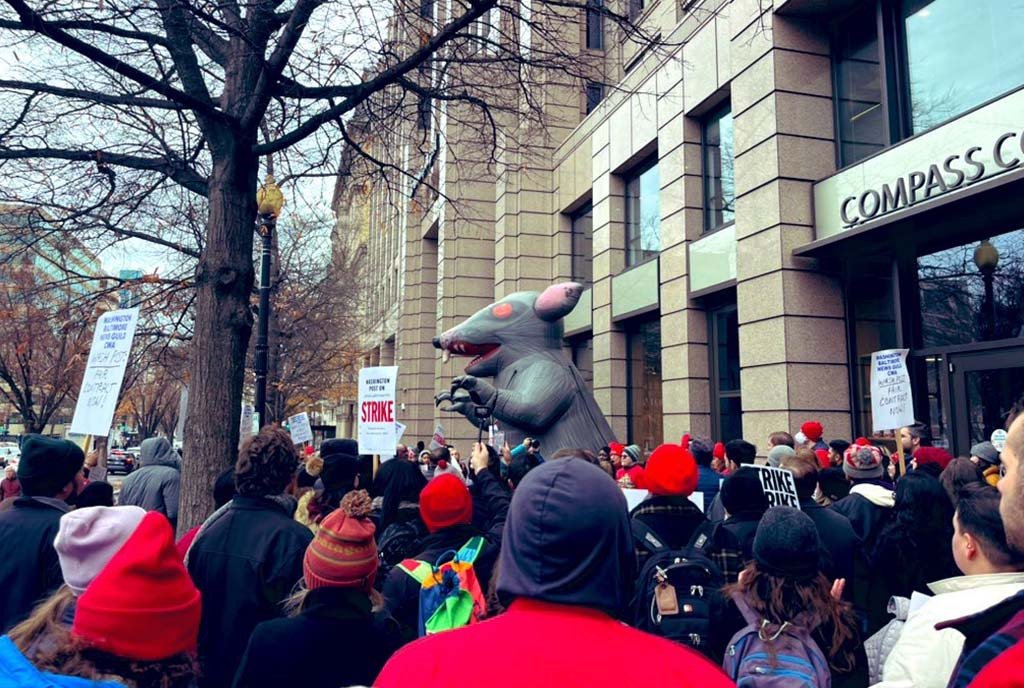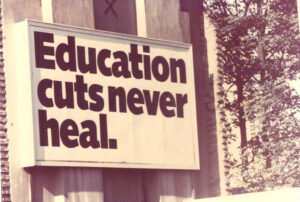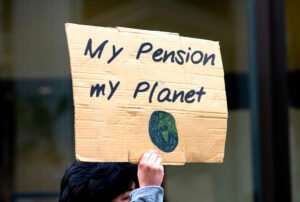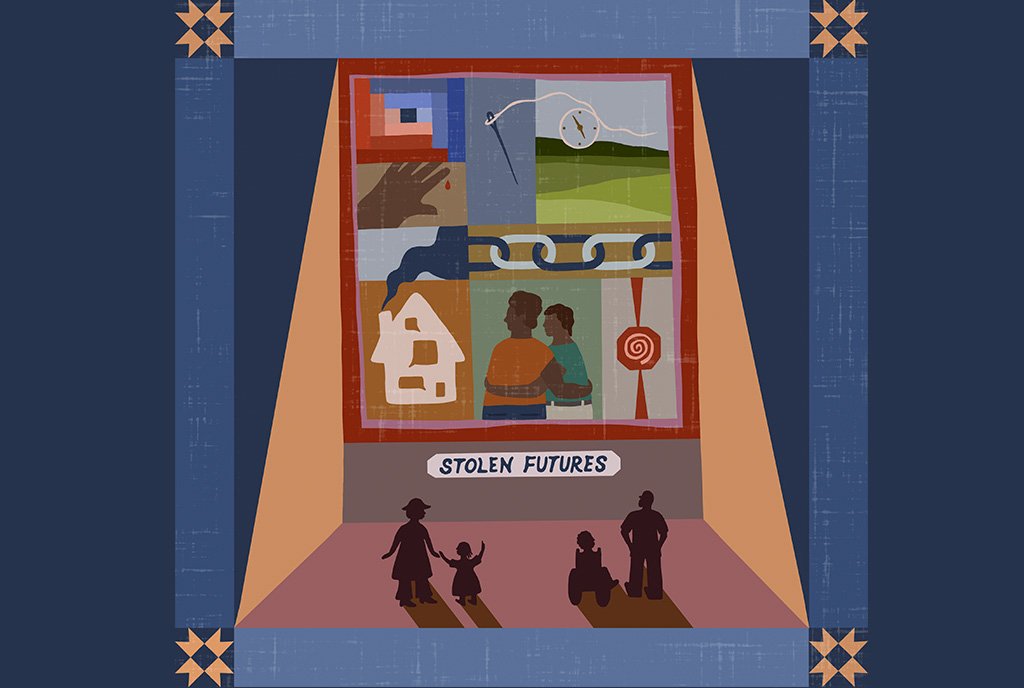
“Everybody’s a labor reporter today!” cried Sara Nelson, president of the Association of Flight Attendants (AFA) union, to hundreds of workers crowded outside the Washington Post office. On December 7, union members at the Post walked off the job for 24 hours. The walkout was the biggest labor action by Post workers in almost 50 years, protesting layoffs, salary floors, and stalled contract negotiations. And as of December 14, it was working—the union was headed back to the bargaining table.
Brutal cost-saving measures at the nation’s largest news platforms are not happening without a fight. From the Washington Post Guild strike to the mission of nonprofits like the Economic Hardship Reporting Project, media workers are insisting not only that company executives can change course but are also setting the record straight by telling their side of the story. “This work matters,” said Nelson to the strikers. “It matters to a free society. It matters to democracy.”
Layoffs by Another Name
The action by Post Guild members comes at the end of one of the most unstable years in the media sector. The industry itself has been facing a financial crisis, and corporate owners like Gannett, GateHouse Media, and Alden Global Capital have drastically shrunk departments and heavily cut staffing. In June, Axios reported that 2023 was so far a record year for cuts in the industry; at that time, media had lost 17,436 jobs. Large platforms and newsrooms, such as Vox Media and NBC, forecasted layoffs in January, while others including Vice News, Buzzfeed News, and Jezebel, restructured or shut down completely.
In response to these pressures, organizing has grown all over media—and the Post Guild is no exception. Unions have combatted sector decline by organizing major city newspapers such as the Chicago Tribune and Los Angeles Times as well as online platforms and print magazines like HuffPost, the Atlantic, Slate, the New Yorker—the list goes on. Around 75 percent of eligible Post employees are union members—almost doubling the membership of five years ago.
“What happens at this time next year when economic headwinds don’t change?”
Jon Schleuss, president of the NewsGuild-CWA union, addressed the crowd with an energetic message about the NewsGuild’s growing mass and militant action. The NewsGuild is 26,000 members strong, spanning across 440 locals. In 2023 alone, Schleuss told the crowd, they have gone on 34 strikes at outlets including the New York Times, the Pittsburgh Post-Gazette, and more. The Post Guild action made it 35.
The Post management has proposed cutting 240 people, about 10 percent of its staff, through “voluntary buyouts” incentivizing workers to leave the company. A statement by the Post Guild explained that its members were staging a walkout in response to these measures: “Despite a year and a half of efforts, Post management has refused to bargain in good faith for a fair contract that keeps up with inflation and the Post’s competition.” After 18 months of bargaining for better pay, the union stated, the company is taking an aggressive course to make up for the missing $100 million in revenue.
Schleuss told NPQ that “voluntary buyouts are just layoffs in another name,” putting the burden of bad management at the paper on the backs of Post workers. “It’s shameful,” said Schleuss, “that the Post, which is owned by billionaire Jeff Bezos, would refuse to invest in the journalism that the US needs. I’m a local subscriber and depend on the Post to know what’s happening in DC—and like millions of others, [I] deserve a good news source.”
Derek Hawkins, an enterprise reporter for the Washington Post’s national desk, echoed the concerns about voluntary buyouts at the December 6 strike. “These measures are funded through our pension fund—they don’t cost Jeff Bezos a penny—and they’re not a good cost-saving measure.” Hawkins added that shrinking the Post’s workforce will cause the paper to “lose institutional knowledge and young, energetic, highly skilled workers.” Instead of finding alternatives for freeing up money, he said, the company is resorting to thinning out the workforce with no guarantee that it will stabilize the bottom line in the future: “What happens at this time next year when economic headwinds don’t change?”
New Solutions, Old Problems
As billionaires buy up large media platforms and workers in the sector struggle against the sector’s decline, other media organizations are trying to create space where reporters can tell real stories about why all—including media workers—are taking losses in this economy. The Economic Hardship Reporting Project (EHRP), cofounded by journalists and advocates Barbara Ehrenreich and Alissa Quart, does exactly that, funding original reporting by independent journalists from diverse economic backgrounds. Not only does it not answer to billionaires like Bezos, but its funded writers are also able to speak the truth about what effect things like private ownership has had on their lives.
The EHRP believes that it’s important to challenge traditional narratives of economic class and issues, as these not only harm individual workers but allow harmful economic trends to worsen unchecked. The project aims to move media away from reproducing harmful class mobility myths like self-reliance, individual success, and bootstrapping. Alissa Quart told NPQ why economic crises need better storytelling by economically diverse reporters.
“I call it ‘experiential expertise,’” said Quart. “Our project started as a way to break down the division between the neutral, ‘Ivy-Plus’ educated reporter who comes from relative or extreme privilege writing about people in poverty versus people who have lived different kinds of economic insecurity reporting on their own or others’ experience.”
News written by EHRP reporters yields unexpected and much-needed areas of coverage. In the organization’s recently released collection Going for Broke: Living on the Edge in the World’s Richest Country, media workers share how they struggled to make ends meet and enter the profession. Alex Miller, a former Navy veteran, tells a story in the collection about returning from deployment. As a struggling veteran, he was forced to perform his desperation and stay persistent when interacting with bureaucratic aid systems for needed services. “If he hadn’t written about that experience,” Quart asks, “would we know that story?”
Sign up for our free newsletters
Subscribe to NPQ's newsletters to have our top stories delivered directly to your inbox.
By signing up, you agree to our privacy policy and terms of use, and to receive messages from NPQ and our partners.
Quart points out that the granularity of economic experience is something that doesn’t necessarily occur to mainstream media reporters—a statement that resonates at a time when more Americans than ever are experiencing economic insecurity while economists tell us the economy is fine. The danger of this is that poverty can be “exoticized,” she explains, and condescension can creep in.
Economic crises sometimes bring forth bold movements ready to speak the truth about everyday people.
The Economic Hardship Reporting Project emerged in 2012, at a time of stark inequality in the wake of the 2008 global recession. Between 2009 and 2014, the number of billionaires doubled as working people fell further behind. Today, Quart notes, media advocates are pushing to fund the local news, unionize newsrooms, start independently funded papers, and forge partnerships between nonprofit newsrooms. But there is also a troubling capture of media by private ownership, mass layoffs in legacy media publications, and plummeting fees for freelancers. Quart says that the people who are living on freelance fees are receiving “1990s level” compensation—or around $1 per word. In other words, wages haven’t increased in 30 years—a phenomenon seen across the economy.
To combat this degradation in the sector, EHRP provides funding to freelance reporters and co-publishes their pieces with other newsrooms. In the era of the private equity buyouts of local papers and billionaire ownership of media giants like the Washington Post and Twitter, their work has gotten even harder. As “elite capture has accelerated,” says Quart, so too has the emphasis on “bipartisan” coverage—which generally leans toward the centrist or conservative end of the political spectrum.
The original vision that Quart piloted with Ehrenreich was aimed at mitigating these economic and political problems within media by telling better stories about the economy. The hope, as Quart puts it, is that journalism could be more of “a commons—and that’s what multiple partners and non-and-for-profit blends can bring, along with their resources. This can bring a greater, cross-institutional solidarity, and less of a capitalist relationship to news production.”
Economic crises sometimes bring forth bold movements ready to speak the truth about everyday people. The fallout of the COVID-19 pandemic, for example, led to a huge rise in coverage of essential workers, the “Great Resignation,” and other shifts in labor organizing—such as the recent resurgence of organizing and popularity of labor unions at companies like Starbucks and Amazon. The recent strike by the United Auto Workers, for example, has led to unprecedented nationwide coverage of the struggle between the union and major auto companies. Part of that shift is surely due to a change in internal union culture—newly elected UAW President Shawn Fain ran on a platform of reviving union democracy and reengaging a membership that had long been left behind by its leaders—and a commitment to reaching out to a struggling US public.
For her part, Quart is heartened by that coverage, as labor reporting has not always been prioritized in newsrooms. “A lot of those beats were phased out, and now you see a resurgence of interest.” Papers of record usually take the position of the “business class,” as Quart puts it, focusing on a strike’s effects on “the consumer, the stockholder, and the company.” But new and creative forms of organizing have led to more visibility of the fact that workers across the economy are facing things like layoffs, insufficient pay, and risk across the economy.
Media workers have often been very visible on this issue, as many are contract workers who don’t have the benefits or work protections that provide stable employment—let alone a living wage. But they have the doubled advantage of being able to tell stories about that problem. Quart shares Barbara Ehrenreich’s insight that “being a reporter and being an advocate are not necessarily incompatible—in fact, they are part of the same thing.”
Labor unions and nonprofit news organizations are fighting not only for better jobs but against the foreclosure of information.
Democracy Dies in Darkness—Workers Bring the Light
At the Post Guild picket line, several reporters and union leaders from AFA, the American Postal Workers Union, and the Communications Workers of America had similar angles on what was happening not only at the Post, but in the United States writ large. Jeff Bezos bought the company in 2013, but ownership by the world’s second-richest man has not helped it thrive. Countless studies show that private ownership, shareholder primacy, and consolidation of corporate governance has only hurt most people except the wealthy few.
The Post’s slogan, “Democracy Dies in Darkness,” speaks to how good reporting is key to telling the truth about our reality. As newsrooms across the country struggle to survive, labor unions and nonprofit news organizations are fighting not only for better jobs but against the foreclosure of information.
On the picket line, Sara Nelson closed her speech by telling Post Guild workers that their reporting was key for accountability not only in the airline industry but in all other sectors. Without their writing, she said, people everywhere wouldn’t have widespread access to why things aren’t working for working people. Jon Schleuss had a similar message for his members, riffing on the paper’s slogan to rile the crowd: “Democracy dies in darkness! Who brings the light?” The crowd shouted back: “We do!”











